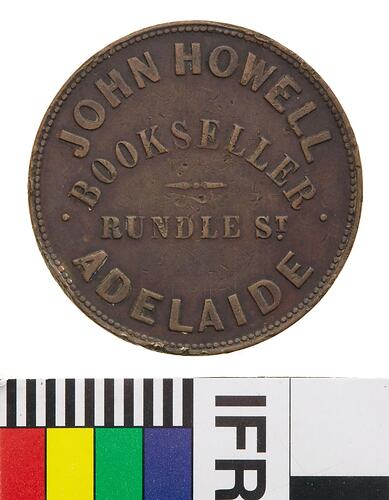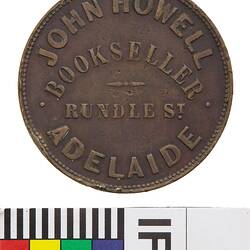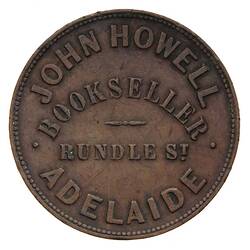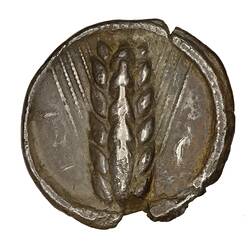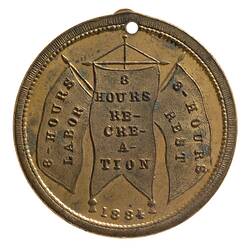Summary
Copper One Penny Token, minted by an unknown British mint. Issued by John Howell, Liverpool Cheap Book Depot, Adelaide, circa 1858. Surcharged in three lined C. JENKINS / AUCTIONEER / ADELAIDE. The earliest mention of a bookseller by the name of John Howell was in 1855 when he had a premises in Hindley Street and in Strangways Terrace, North Adelaide. Howell seems to have built a substantial business quite rapidly. During 1858 he took out extensive advertisements in the Books and Stationery advertisements section of the Adelaide Advertiser. By 1864 he had moved to 4 Rundle Street and in addition to his books, music and stationery, his advertisement prominently announced that his business was a 'Depository of the Society for the promotion of Christian Knowledge.'
Previouse Collections: George McArthur
Physical Description
A round copper trade token (34 mm diameter) giving the name, address and business of the issuing firm: John Howell, Rundle St. Adelaide, Bookseller - Liverpool Cheap Book Depot. The reverse features a representation of the mythical Liver bird, featured on early Arms of Liverpool. The Liver holds a sprig of olive in its beak (interpreted by Chitty as a 'liver weed', the sea-weed that proliferated in the estury near Liverpool) and stands on a length of rope. The die alignment is 06.
Obverse Description
JOHN HOWELL / BOOKSELLER / _._ / RUNDLE ST / . ADELAIDE .
Reverse Description
At centre a liver bird facing left holding an olive branch in beak; above, LIVERPOOL; below, CHEAP BOOK DEPOT
Edge Description
Plain
More Information
-
Collection Names
-
Collecting Areas
-
Acquisition Information
Transfer from National Gallery of Victoria (NGV), George McArthur, 15 Mar 1976
-
Date Issued
circa 1858 AD
-
Issued By
John Howell, Liverpool Cheap Book Depot, Adelaide, Greater Adelaide, South Australia, Australia, circa 1858
-
Inscriptions
Obverse: JOHN HOWELL BOOKSELLER RUNDLE ST. ADELAIDE Reverse: LIVERPOOL CHEAP BOOK DEPOT
-
Denomination
-
Series
-
Material
Copper
-
Axis
06
-
Classification
-
Category
-
Discipline
-
Type of item
-
Dimensions
34 mm (Outside Diameter), 14.063 g (Weight)
-
Shape
Round
-
References
The John Howell token issue records an address change from Hindley (obverse A) to Rundle streets. At Rundle two slightly different obverse dies were employed - these are most easily differentiated by the form of stop under the T of ST; if a line it is obverse B if a bead it is obverse C. The reverse seems to have employed only one die but it may have been hubbed in the complete form. The weight and die alignment also help differentiate the three issues. The Hindley St. issue has an average weight of around 15.8g and dies set at 12 o'clock, the firsl Rundel St. issue has a lower weight average of about 14.8 g and the same die alignment while the third issue, also from Rundle st. has the lightest average weight, 14.0 g and the dies set at 6 o'clock. This token was struck from obverse C and has the die alignment of 06. The Liver Bird Another area of debate about the origins of the name Liverpool focuses upon the bird on the Liverpool seal. The name 'liver' is said to come from a type of waterfowl, named liver, or lever. The borough arms have been presented as proof of this but it has been suggested that no bird of that type has been found in the Liverpool area. The historian Sir J. A. Picton noted that the symbolic bird of Liverpool was the Eagle of St John, which meant that the name liver should not have been attributed to the bird. This theory is less certain due to the evidence presented by the town seal. By 1829 the seal featured an aquatic style, or water, bird which looked like a crane but the bird on the corporation seal (a copy of which is in Matthew Gregson's Fragments of the History of Lancashire) was not aquatic. The image on this seal is said to appear to be a dove with an olive branch, which had been made to look like seaweed. If this was the case, then the origin of the name was said to be topographical or related to the area itself. [Link 1]
[Thesis] Lugton, Mary E. 1989. George McArthur of Maldon: his Life and his Book Collection.
[Catalogue] Morrison, Ian. 2003. The Baker of Maldon.
[Book] Andrews, Arthur. 1921. Australasian Tokens and Coins., No. 274
[Book] Heyde, Gilbert C. & Skinner, Dion H. 1967. Unofficial Coins of Colonial Australia and New Zealand., No. 124/1
-
Keywords
